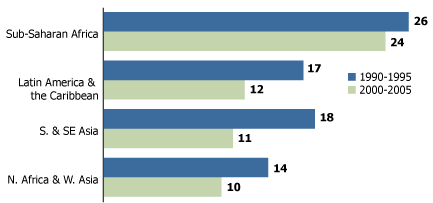
Unmet Need for Family Planning Persists in Developing Countries
(October 2007) Rates of unmet need for family planning remain high in developing countries, according to a recently released report from the U.S.-based Guttmacher Institute.1 According to surveys, one in seven married women in these countries has an unmet need for contraception. But in sub-Saharan Africa, the ratio is nearly 1-in-4.
Women with “unmet need for family planning” are women of reproductive age who prefer to avoid or postpone childbearing, but are not using any method of contraception. Since the 1960s, when the concept was first developed, addressing unmet need has become the basis for many family planning and population programs around the world.2
Limited Progress
Using data from Demographic and Health Surveys, the authors of the Guttmacher report concluded that between the periods of 1990 to 1995 and 2000 to 2005, unmet need declined only 2 percent in sub-Saharan Africa. In other regions of the developing world—including Latin America and the Caribbean, North Africa and West Asia, and South and Southeast Asia—more progress has been made and unmet need has fallen between 4 percent and 7 percent.
Percent of Married Women With an Unmet Need for Contraception, by Region, 1990-1995 and 2000-2005

Note: Women are defined as having unmet need if they say they prefer to avoid a pregnancy but are not using contraception.
Source: Gilda Sedgh et al., Women With an Unmet Need for Contraception in Developing Countries and Their Reasons for Not Using a Method (New York: Guttmacher Institute, 2007).
Regional averages can mask wide differences in unmet need among countries. For example, in Latin America and the Caribbean, only 6 percent of women in Brazil have an unmet need, while 40 percent of women in Haiti have an unmet need for contraception.
Obstacles to Reducing Unmet Need
Barriers to implementing effective family planning programs and reducing unmet need for contraception persist for various reasons, according to the report’s authors:
- A woman does not believe she is at risk of getting pregnant, she is not informed about contraceptive methods, or she is concerned about health risks and side effects.
- Contraception is not readily available or the range of available methods is limited.
- The woman, her partner, or other close family members are opposed to family planning methods.
The reasons women cite for not using contraception vary across regions and countries. For example, in North Africa and West Asia, more than 60 percent of women with unmet need do not use contraception because they believe they are not at risk of getting pregnant. In Latin America, about half of women cited this reason. And in both South and Southeast Asia and sub-Saharan Africa, approximately 35 percent of women cited this reason.
Some progress has been made in making women better informed about their contraceptive options. The share of married women citing lack of knowledge to explain why they don’t use contraceptives has plummeted since the 1980s. In the late 1980s, 25 percent to 44 percent of women gave this reason. In the surveys since 2000, from zero percent to 12 percent of women said they were not using contraception because they were uninformed.
Why Women Don’t Use Contraception
However, more women today choose not to use contraception because they are concerned about the health risks and side effects of various methods, or they find contraception too inconvenient to use. Six percent to 28 percent of married women in the late 1980s cited one of these method-related reasons, but 19 percent to 36 percent of women more recently said the same. This suggests that, although programs have been successful in educating women about their family planning options, a number of both perceived and real risks associated with some forms of contraception continue to prevent use.
A Tactical Shift
To solve the continuing problem of unmet need, family planning advocates have shifted their aim from focusing solely on decreasing the environmental, economic, and societal pressures of population growth to encouraging couples to achieve their personal fertility goals by helping them choose the number and spacing of pregnancies. Social scientists believe combating unmet need will benefit women, especially in developing countries.
If a woman is able to control how many children she has and when, she may limit the health risks, such as death and disability associated with unsafe abortions performed to eliminate mistimed or unwanted pregnancies; become more educated and increase her employment opportunities; participate more in social and political life; and improve her standard of living.
Taking into account the attitudes and behaviors of women in the developing world, the authors suggest the following to address unmet need:
- Focus on the underserved populations, most notably women in sub-Saharan Africa, including both the poorest women in all regions and those in rural areas.
- Diversify and improve contraceptive methods and offer counseling on the most appropriate methods for each woman.
- Raise awareness and continue family planning education efforts with a focus on addressing unrealistic perceptions of risk.
- Offer better educational and economic opportunities for women, which can empower women and promote long-term cultural change in favor of family planning.
Sara Maki is a PRB intern.
References
- Gilda Sedgh et al., Women With an Unmet Need for Contraception in Developing Countries and Their Reasons for Not Using a Method (New York: Guttmacher Institute, 2007), accessed online at www.guttmacher.org, on Aug. 27, 2007.
- John B. Casterline and Steven W. Sinding, “Unmet Need for Family Planning in Developing Countries and Implications for Population Policy,” Policy Research Division Working Paper 135 (2000), accessed online at www.popcouncil.org, on Aug. 27, 2007.
See also: Lori Ashford, Unmet Need for Family Planning: Recent Trends and Their Implications for Programs (Washington, D.C.: Population Reference Bureau, 2003). Available online at www.prb.org/pdf/UnmetNeedFamPlan-Eng.pdf.
